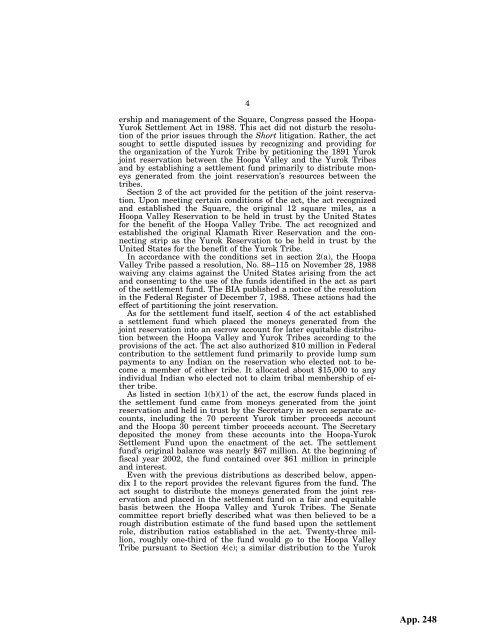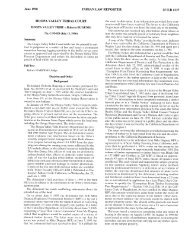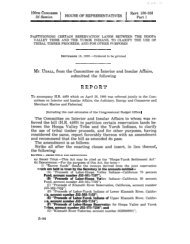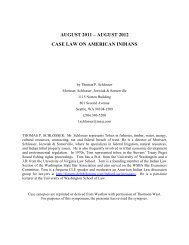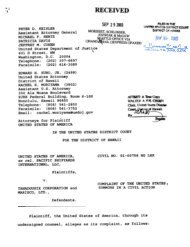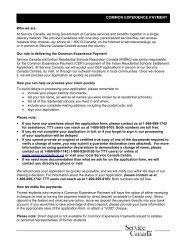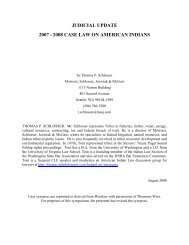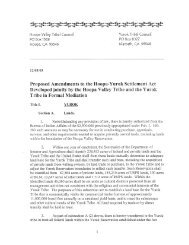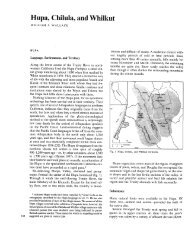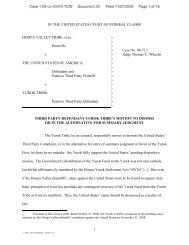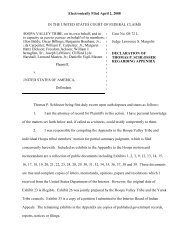Hoopa appendix supporting summary judgment - Schlosser Law Files
Hoopa appendix supporting summary judgment - Schlosser Law Files
Hoopa appendix supporting summary judgment - Schlosser Law Files
Create successful ePaper yourself
Turn your PDF publications into a flip-book with our unique Google optimized e-Paper software.
4<br />
ership and management of the Square, Congress passed the <strong>Hoopa</strong>-<br />
Yurok Settlement Act in 1988. This act did not disturb the resolution<br />
of the prior issues through the Short litigation. Rather, the act<br />
sought to settle disputed issues by recognizing and providing for<br />
the organization of the Yurok Tribe by petitioning the 1891 Yurok<br />
joint reservation between the <strong>Hoopa</strong> Valley and the Yurok Tribes<br />
and by establishing a settlement fund primarily to distribute moneys<br />
generated from the joint reservation’s resources between the<br />
tribes.<br />
Section 2 of the act provided for the petition of the joint reservation.<br />
Upon meeting certain conditions of the act, the act recognized<br />
and established the Square, the original 12 square miles, as a<br />
<strong>Hoopa</strong> Valley Reservation to be held in trust by the United States<br />
for the benefit of the <strong>Hoopa</strong> Valley Tribe. The act recognized and<br />
established the original Klamath River Reservation and the connecting<br />
strip as the Yurok Reservation to be held in trust by the<br />
United States for the benefit of the Yurok Tribe.<br />
In accordance with the conditions set in section 2(a), the <strong>Hoopa</strong><br />
Valley Tribe passed a resolution, No. 88–115 on November 28, 1988<br />
waiving any claims against the United States arising from the act<br />
and consenting to the use of the funds identified in the act as part<br />
of the settlement fund. The BIA published a notice of the resolution<br />
in the Federal Register of December 7, 1988. These actions had the<br />
effect of partitioning the joint reservation.<br />
As for the settlement fund itself, section 4 of the act established<br />
a settlement fund which placed the moneys generated from the<br />
joint reservation into an escrow account for later equitable distribution<br />
between the <strong>Hoopa</strong> Valley and Yurok Tribes according to the<br />
provisions of the act. The act also authorized $10 million in Federal<br />
contribution to the settlement fund primarily to provide lump sum<br />
payments to any Indian on the reservation who elected not to become<br />
a member of either tribe. It allocated about $15,000 to any<br />
individual Indian who elected not to claim tribal membership of either<br />
tribe.<br />
As listed in section 1(b)(1) of the act, the escrow funds placed in<br />
the settlement fund came from moneys generated from the joint<br />
reservation and held in trust by the Secretary in seven separate accounts,<br />
including the 70 percent Yurok timber proceeds account<br />
and the <strong>Hoopa</strong> 30 percent timber proceeds account. The Secretary<br />
deposited the money from these accounts into the <strong>Hoopa</strong>-Yurok<br />
Settlement Fund upon the enactment of the act. The settlement<br />
fund’s original balance was nearly $67 million. At the beginning of<br />
fiscal year 2002, the fund contained over $61 million in principle<br />
and interest.<br />
Even with the previous distributions as described below, <strong>appendix</strong><br />
I to the report provides the relevant figures from the fund. The<br />
act sought to distribute the moneys generated from the joint reservation<br />
and placed in the settlement fund on a fair and equitable<br />
basis between the <strong>Hoopa</strong> Valley and Yurok Tribes. The Senate<br />
committee report briefly described what was then believed to be a<br />
rough distribution estimate of the fund based upon the settlement<br />
role, distribution ratios established in the act. Twenty-three million,<br />
roughly one-third of the fund would go to the <strong>Hoopa</strong> Valley<br />
Tribe pursuant to Section 4(c); a similar distribution to the Yurok


